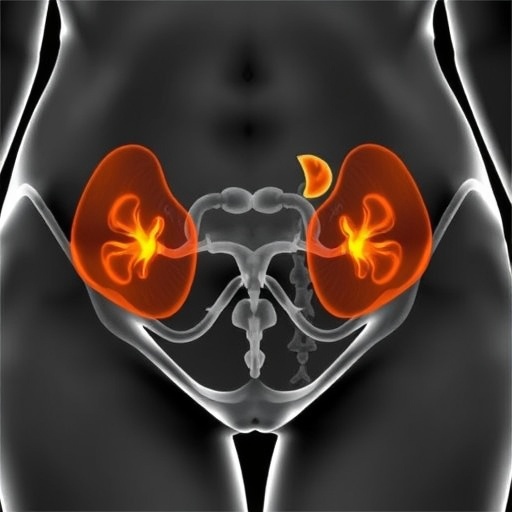The presence of adenomyosis—a benign uterine condition characterized by the invasion of endometrial tissue into the myometrium—has long intrigued gynecologic oncologists regarding its influence on the prognosis of endometrial cancers. In a groundbreaking new study published in BMC Cancer, researchers have rigorously assessed the survival outcomes of patients with non-endometrioid endometrial cancer (EC) in the context of uterine adenomyosis, uncovering findings that could reshape clinical perceptions and management strategies in this domain.
Non-endometrioid endometrial cancer represents a distinct and often more aggressive subset of EC, marked by histopathological differences compared to the more common endometrioid type. The clinical implications of coexisting adenomyosis in this subset have, until now, remained ambiguous. This study encompassed a comprehensive retrospective analysis, drawing on data from a single tertiary center over a remarkable 25-year span from May 1998 to March 2023. The inclusion criteria focused on patients with histologically confirmed non-endometrioid EC who had undergone primary surgical treatment.
Out of 139 patients analyzed, 40 were identified with concurrent adenomyosis, while 99 had no histological evidence of the condition. The analysis pivoted on a comparative evaluation of survival outcomes, correlating clinical and pathological variables with the presence or absence of adenomyosis. Parameters such as age, body mass index (BMI), menopausal status, tumor grade, depth of myometrial invasion, lymphovascular space involvement, lymph node metastasis, and distant spread were meticulously catalogued to control for confounding factors.
Surprisingly, the study revealed that the presence of adenomyosis did not significantly correlate with the traditional pathological markers used to gauge tumor aggressiveness in non-endometrioid EC. Variables like myometrial invasion, tumor diameter, and lymphovascular invasion showed no statistically significant differences between the two cohorts, challenging prior assumptions about the tumor microenvironment’s interaction with adenomyotic tissue.
Despite the lack of difference in these pathological features, the survival outcomes portrayed a compelling story. Disease-free survival (DFS) was statistically comparable between patients with and without adenomyosis, suggesting that recurrence rates were not drastically influenced by adenomyotic involvement. However, the overall survival (OS) data presented a statistically significant divergence—patients harboring adenomyosis demonstrated markedly enhanced survival compared to their counterparts without adenomyosis.
This distinction in OS, with adenomyosis patients surviving on average 172 months versus 102 months for those without it, raises intriguing biological questions. It suggests that adenomyosis may exert a protective or modifying effect on the tumor’s behavior or on systemic responses to the malignancy. The underlying mechanisms for this survival benefit remain speculative but might involve modulation of the local immune milieu or alterations in myometrial tissue characteristics.
These findings could recalibrate oncological prognostication in non-endometrioid EC. The common narrative that uterine adenomyosis complicates or worsens gynecological cancers may not hold true uniformly across all tumor subtypes. Instead, adenomyosis might interact distinctly with certain aggressive cancer phenotypes, potentially mediating pathways that enhance longevity despite comparable recurrence risks.
Moreover, this study underscores the importance of nuanced pathological evaluation when staging and planning adjuvant therapies. The dissociation between DFS and OS signals the need for future research to unravel the complex biology underpinning survival advantages, possibly exploring immunophenotyping or genomic profiling in adenomyosis-affected tumors.
Clinicians may also consider these insights when counseling patients concerning prognosis and treatment expectations. While adenomyosis does not appear to alleviate recurrence risk, its association with improved OS warrants attention as a favorable prognostic indicator, especially in a cancer subtype with typically poorer outcomes.
The methodology employed in the 25-year longitudinal dataset exemplifies meticulous clinical data curation and real-world applicability. The survival analyses performed via Kaplan-Meier estimates reinforce the rigor of findings, while the singular institutional backdrop ensures consistency in pathological assessment, albeit limiting generalizability, which should be addressed in multicentric follow-ups.
Complementing these statistical revelations, the study aligns with emerging literature emphasizing the complex role of uterine microenvironments in dictating cancer dynamics. The benign yet invasive nature of adenomyosis may induce microvascular or stromal alterations that impede metastatic progression or enhance responsiveness to systemic therapies.
Notably, the authors’ exclusion of patients lacking complete clinical or surgical data bolsters the credibility of findings, minimizing biases introduced by incomplete records. This methodological fortitude allows a clearer interpretation of adenomyosis’ impact, distinct from confounding variables.
The profound survival disparity elucidated invites a broader exploration into how benign gynecological conditions intersect with malignancies, potentially unveiling novel therapeutic targets or biomarkers. Adenomyosis, traditionally treated as a symptomatic nuisance, might harbor clues to modulating cancer progression.
As research advances, integrating molecular and immunological profiling with clinical data will be imperative. Understanding whether adenomyosis fosters an immunologically active tumor microenvironment or affects hormone receptor expression could transform therapeutic paradigms for non-endometrioid EC.
In summary, this pivotal study challenges entrenched dogma by demonstrating that uterine adenomyosis is independently associated with superior overall survival in patients with non-endometrioid endometrial cancer without altering key pathological factors or disease-free survival. The implications resonate deeply for patient stratification, prognostication, and future research pathways that intertwine benign and malignant uterine pathology.
For oncologists and gynecologists, these findings demand a reassessment of adenomyosis within the complex tapestry of endometrial cancer biology, heralding a new chapter where benign uterine changes are scrutinized for their potential to influence malignant courses.
This research, led by Ozgen, Yalcin, and Abay and published by BMC Cancer in 2025, paves the way for subsequent investigations aiming to elucidate mechanistic underpinnings and translate observational data into therapeutic innovation.
Subject of Research: Investigation of the impact of uterine adenomyosis on survival outcomes in patients with non-endometrioid endometrial cancer.
Article Title: Impact of uterine adenomyosis on survival outcome of patients with non-endometrioid endometrial cancer.
Article References:
Ozgen, L., Yalcin, Y., Abay, M. et al. Impact of uterine adenomyosis on survival outcome of patients with non-endometrioid endometrial cancer. BMC Cancer 25, 1574 (2025). https://doi.org/10.1186/s12885-025-14815-4
Image Credits: Scienmag.com




